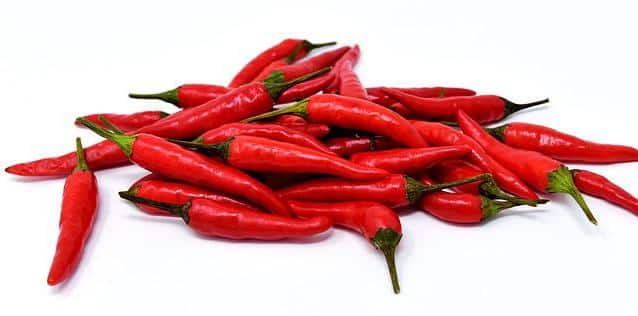Okay so you put too much capsaicin on your skin and now you’re feeling the volcanic-level burn to the point that you can’t function.
You’re sweating, can’t think straight, and just want the burning to stop – what the hell can you do to reduce the burning and get back to normal as quickly as possible?

Capsaicin: An Uncommon Exposure & Unusual Treatment (2019)
A case report by Yenigun & Thanassi provides insight regarding potentially effective strategies for treating burning skin resulting from application of capsaicin. (R)
- Capsaicin (the active component of chili peppers) is a hydrophobic, fat-soluble phenol alkaloid that elicits significant pain and burning upon tissue and mucous membrane exposure.
- It also causes neurogenic inflammation through interaction with sensory neurons transient receptor potential vanilloid 1 (TRPV1). (R)
- In 2017, the American Association of Poison Control Centers reported 2,229 exposures to capsicum-containing peppers – 215 of which were treated in a healthcare facility.
- “The hydrophobic nature of these compounds explains why water and other hydrophilic solvents are minimally effective in alleviating their noxious effects.”
- Various strategies for neutralizing the pain and burning of capsaicin exposure have been explored, including: baby shampoo, mixtures of detergent solutions, milk, topical anesthetics, and antacid solutions (e.g. calcium carbonate).
- Specialized decontaminants including: Sudecon wipes, SABRE Decon, and BioShield sprays are commonly used by law enforcement to neutralize capsaicin.
Case report: 22-year-old female; severe pain and burning of vaginal mucosa from capsaicin-based pepper spray (which got onto one of her tampons).
Management strategies
Morphine (4 mg, intravenous): Had no observed effect over 15-minute period.
Following morphine, management was focused on neutralizing and displacing capsaicin from the mucosa.
- 2% lidocaine jelly: Lubricated medium-sized, disposable plastic speculum. Speculum exam was performed and found notable vaginal mucosal erythema without ulcerations or bleeding.
- 2 tampons presoaked in cold, pasteurized 2% skim milk: Milk-soaked tampons were placed in-line with the vaginal canal and speculum was removed – leaving the tampons in place with strings hanging out for easy removal.
- Icepack & milk-soaked towel: An icepack and milk-soaked towel were then placed over the patient’s groin.
The patient achieved significant pain relief in 5-7 minutes (pain reduced from 10/10 to 3/10).
After a 15-minute “dwell-time” the tampons were removed, the patient was observed briefly, then sent home in stable condition.
Takeaway notes:
Capsaicinoids are best displaced via hydrophobic solutes. Topical anesthetics such as lidocaine are effective in temporarily relieving pain via inhibition of sensory neurons.
Hydrophilic substances (like water) will have little to no effectiveness in displacing hydrophobic molecules (like capsaicin) from sensory receptors.
Milk, on the other hand, contains the hydrophobic protein “casein” which effectively displaces capsaicin, quickly relieving pain.
Of relevance is the fact that 10% glucose solutions have also been shown to decrease pain associated with capsaicin exposure – but they’ve only been studied in the oral cavity (and may not be effective in other areas of the body).
How To Get Capsaicin Off Skin & Stop Capsaicin Burning (Neutralize & Displace)
You may not have access to things like lidocaine, but you probably have some hydrophobic substances in your fridge or pantry that should be able to ease the burning from capsaicin.
Dairy products (Top Choice)
Dairy products contain casein, a fat-binding protein which displaces capsaicin from TRPV1 receptors – thus quickly and effectively reducing or eliminating the burning sensation.

The coolness (i.e. cold temperatures) of these dairy products should also help (assuming they were stored somewhere cool like the refrigerator).
- Sour cream: This is probably the easiest and most effective intervention to use. Why? It’s already in somewhat of a “paste” – just take a gob and gently rub it onto the burning area.
- Yogurt: Plain yogurt can work extremely well (probably just as well as sour cream) for displacing capsaicin from skin receptors.
- Cottage cheese: Yet another high-casein dairy product that could be used to neutralize capsaicin if it’s causing a strong burning sensation.
- Milk: Soaking/submerging the capsaicin-laden area in milk and/or soaking a paper towel in milk and gently rubbing or leaving the milk-soaked paper towel on the area should help.
Soap (dish, table, etc.) + cold water
One of the first things people try to alleviate capsaicin-related burns is a combination of soap (dish, table, hand) and cold water.
In many cases – this method works well and is less messy than applying dairy products.
Vegetable oil
Another report online claimed that when calling a nurse asking how to alleviate capsaicin burning (after applying too much to the skin), the nurse recommended vegetable oil – which was very effective.
Cooking oils are hydrophobic and are thought to dilute and possibly displace capsaicin.
(Rub on skin, let it sit for 10-20 minutes, then gently wash off). (Other cooking oils like: olive oil, canola oil, sunflower oil, coconut oil – should work as well).
Soap, water, vegetable oil (combo)
One chemistry enthusiast suggested that adding a little vegetable oil to soap and water should work well as a combination.
Why? The oil provides a separate area for the capsaicin to be dissolved, and the soap/water then prevent it from going back onto your skin.
(Oil dissolves capsaicin and soap/water dissolve the oil).
Vinegar or apple cider vinegar (ACV)
In an online thread, someone claimed that “white vinegar applied with a sponge” worked very well and immediately took the deep burning sensation away.
This may be because capsaicin is acid soluble – and vinegar contains acetic acid.
Be careful not to burn your skin from an overly strong vinegar.
Baking soda
Sodium bicarbonate (a.k.a. baking soda) is a useful abrasive and mild detergent. Some find it helpful for capsaicin burns.
That said, normal soap should theoretically be superior to baking soda here since capsaicin is non-polar.
Corn starch
Some claim that soaking the skin in corn starch can help with capsaicin-related burning.
My guess is that it’s somewhat abrasive and may draw some of the oil out of receptor sites – to mitigate some of the burning.
Ice pack
An ice pack probably won’t directly fix the burning you’re dealing with (because it won’t remove the capsaicin).
That said, applying an ice pack to the skin after some of the other interventions can help further reduce perceived burning.
Rubbing alcohol
Isopropyl (i.e. rubbing) alcohol may provide some relief from capsaicin burn.
This is a solvent that breaks up oils. Probably best to use a small amount and avoid using this on mucosal membranes.
Hydrogen peroxide
According to various websites, hydrogen peroxide changes the structure of capsaicin molecules – which renders them incapable of binding to skin receptors.
Assuming this is true, hydrogen peroxide may prove efficacious against capsaicin-induced burning.
Some believe that efficacy of peroxide is augmented via addition of a base (e.g. baking soda).
Note: Mileage may vary with these methods. If you are unsure of whether a particular method is safe – consult a medical doctor prior to testing.
Other random interventions that people claimed worked…
Below is a list of interventions that random people online claimed were the only things that worked for them. (Use at your own risk).
- Neutragena Acne Facial soap: Makes sense that this would help. Likely hydrophobic. (They tried this specific soap after using other soaps like dish soap, tea tree oil soap, standard soap – and claimed to get “instant relief”).
- Dial soap: Someone mentioned that “Dial” soap provided relief.
- Calamine lotion: Active ingredient is a combination of zinc oxide and 0.5% iron (ferric) oxide. It is believed that calamine lotion works by causing a cooling sensation as it evaporates on skin (to provide relief from the burning). It may also be hydrophobic wherein it displaces capsaicin.
- Urine: I read one account of someone at their wits end who tried many things like dish soap, vinegar, etc. without relief. The person ended up urinating on their hands and rubbing it onto the area and this worked. (Not going to think about the mechanism of action here – may depend on specific urine composition and acidity).
- Specific cocktails: (1) Baking soda mixed with sour cream (2:1 ratio); (2) 1/8 tsp baking soda; 1 tbsp water; 1 tbsp hydrogen peroxide. (Random cocktails that people claim work very well).
Note: The intervention that people assume worked best may not actually be what worked. There may be a slight time delay between application and relief.
For example, someone may apply dairy product – not get much immediate relief – then notice they get relief when doing something wacky like applying urine.
(The relief may have been from the initial remedy – but just taken time due to a delayed action or scrub to wash away the capsaicin).
How long will the burning sensation from capsaicin last?
Assuming you’ve already removed as much of the capsaicin as possible from your skin – you may need to play the waiting game – or keep testing various removal strategies.

It depends on numerous variables:
- Area of body upon which capsaicin was administered (mucosa will yield more severe burning than the skin)
- Strength of capsaicin gel/cream and dosage administered
- Intervention(s) utilized (some will work better than others)
- Duration between burning and intervention
Assuming you use one of the aforementioned intervention strategies, the burning sensation resulting from capsaicin should be relatively short-lived.
Best case scenario: 5-30 minutes. Assuming the mitigation strategy you employed was effective, it should significantly decrease the burning within ~30 minutes.
Less favorable scenario: Suboptimal mitigation strategies may lead to insufficient reduction of burning pain in a timely manner. Some might experience burning for 24-72 hours (i.e. 1-3 days).
Worst case scenario: 2-4 weeks (according to Mayo Clinic). (R) This probably will not happen if you act quickly to neutralize the capsaicin after the burning starts or administer a substance that counteracts capsaicin (e.g. sour cream).
What causes the burning sensation from capsaicin?
Capsaicin binds to transient receptor potential vanilloid 1 (TRPV1) – a specific type of pain receptor.
These receptors then “signal” a burning sensation to your brain.
The more capsaicin you apply – the stronger the TRPV1 activation and corresponding burning sensation.
How I neutralized capsaicin burning my skin…
I’ve written about how I applied an excessive amount of highly-concentrated topical capsaicin to my skin in attempt to reduce itchiness.

Although I probably shouldn’t have administered capsaicin on such a sensitive area, I suspect I also used WAY MORE than I should’ve.
(I did NOT read any dosing instructions – just assumed this stuff was fairly mild and could help with my itch).
It helped with the itch, but felt like a Level 100 Charizard used “Flamethrower” then “Fire Spin” and maybe a few “Blast Burns” – followed by a series of volcanic eruptions and Canadian wildfires.
I broke into a profuse sweat, became nauseous (thought I might vomit), couldn’t think clearly – and contemplated going to the doctor.
- Milk: Thumbs down. I tested “milk” (dipping in and rubbing on via a soaked paper towel). Seemed ineffective. Didn’t provide much of any relief (probably due to the fact that it’s a liquid and has a tendency to drip off the area. That said, even completely submerging the skin in milk didn’t help much for me.
- Sour cream: Massive thumbs up. Sour cream was pure magic. When applying it burned like hell, but within 10-15 minutes I felt a bit better. Applied 2-3 more times at 10-15 minute intervals (over a 45-minute span). Burning sensation down ~90%.
- Hydrogen peroxide: Unknown efficacy. Not sure to what extent this helped, but I applied it after the final application of sour cream. It seemed to help – but maybe that was just the initial work of the sour cream. Either way, this stuff is good for killing bacteria, etc. – so was worth using as the final application.
~2 hours later: Skin is 90-95% recovered. I’m not sure whether the burning sensation will return, but if it does – more sour cream and peroxide will be used. (Update: 24 hours later and ZERO burning. The burning was 100% gone within 6-8 hours.)
What you should avoid doing if capsaicin causing burning sensation?
First of all, use some common sense. If you don’t know what to do – contact a medical doctor ASAP.
- Do NOT try to rinse capsaicin away. It’ll probably cause even more burning if you do this. Remember, capsaicin is hydrophobic (i.e. not hydrophilic) – meaning it does NOT dissolve in water. (Water alone will not displace it from your skin).
- Gentle with soap. Softly dabbing soap in the capsaicin-laden area may be alright (and even helpful) – but might worsen the burning for some.
- Avoid hot baths and showers before/after applying capsaicin cream. Warm water hitting the area (such as from a shower) may cause stinging or burning to intensify.
- Keep the area cool. Warm heat may increase the burning sensation.
- Wear loose-fitting, comfortable clothing. Tight clothing around the area can trap airflow and might exacerbate the burning sensation.
- Follow dosing instructions carefully. Applying a significantly larger dose than prescribed/recommended may be culpable for the painful burning sensation.
What if none of the aforementioned interventions help?
Seek medical attention. If nothing seems to help alleviate the burning sensation resulting from topical capsaicin administration – go see a medical doctor.
Severe burning, swelling, blistering of the skin, and pain are all good reasons to seek medical attention.
A medical doctor will be able to use a combination of things to target localized pain/burning (lidocaine, dairy products, cold packs) – and possibly pain perception (with pain medication).
Moreover, a medical doctor will rule out or treat any damage to your skin or mucosa that may have been inflicted by capsaicin.
Have you dealt with extreme burning from capsaicin?
- Assuming you’ve experienced this, share your story… what happened?
- Which remedies did you try?
- Was there any specific remedy (or concoctions) that helped more than others?